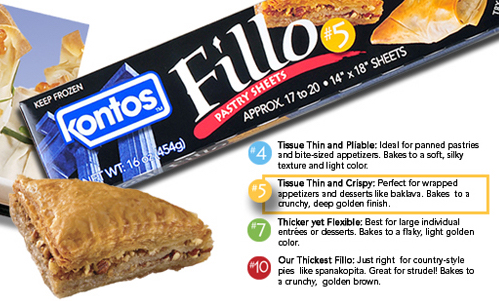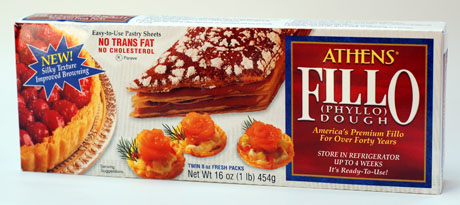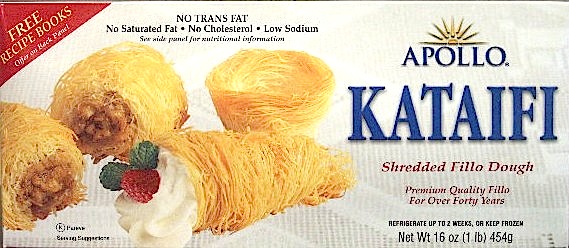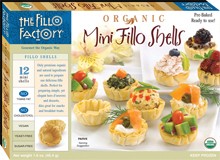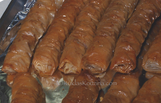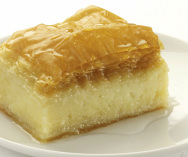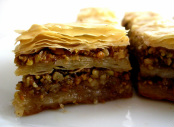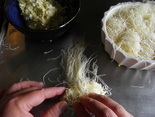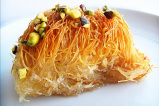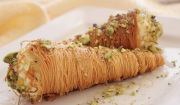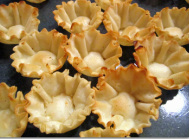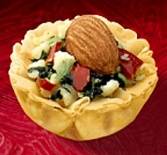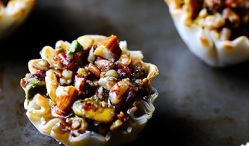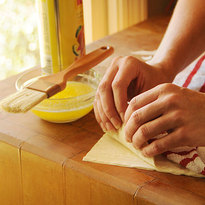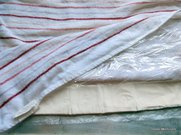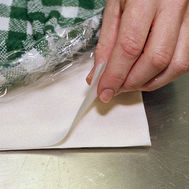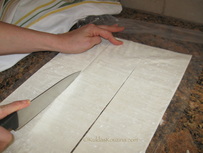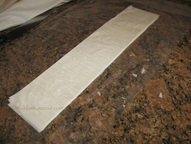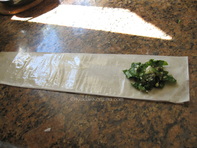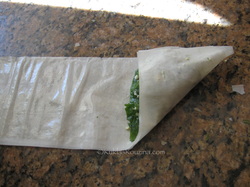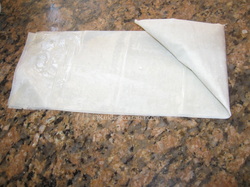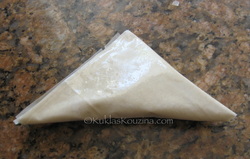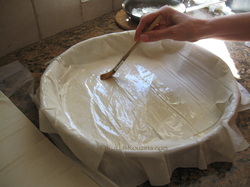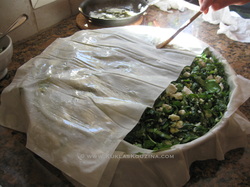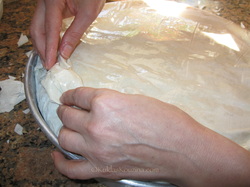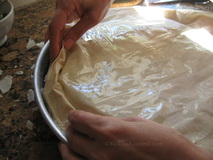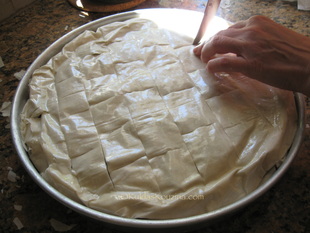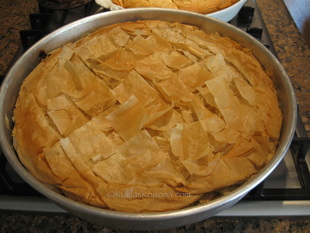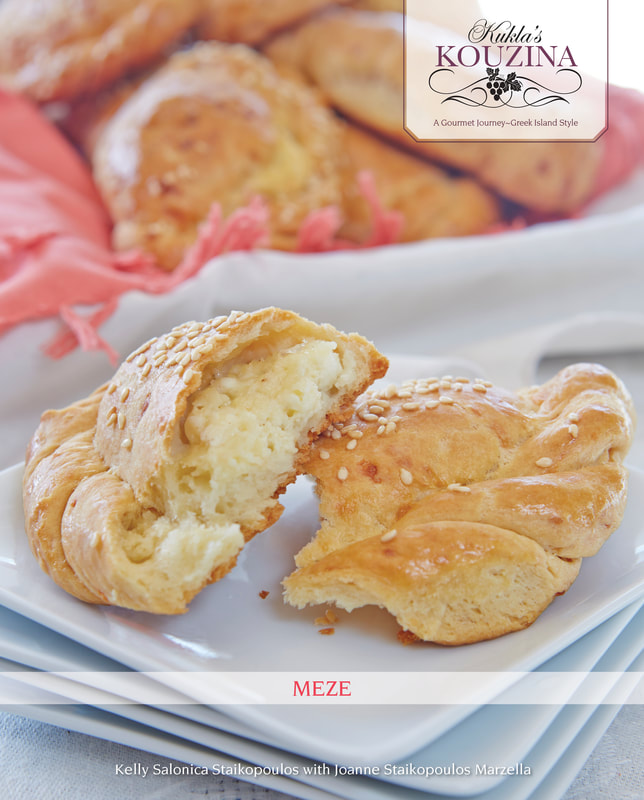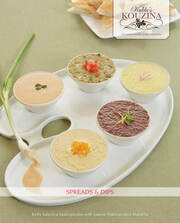Friend Your Fillo
|
The Greek word for friend is filo (φίλο), pronounced FEE-loh.
The Greek word for leaf or sheet is fillo (φύλλο)—as in the thin sheets of pastry dough used in savory and sweet dishes—and is also pronounced FEE-loh. "So...there you go!" [In a Greek accent, rolling the “r” in “there,” of course.] |
First, lets get acquainted with the vast array of fillo-dough products out there so you can simplify your choices and get cooking. The four major fillo brands are Kontos, Athens, Apollo, and The Fillo Factory. (Click on the links here to learn more, and in our Sources section at the end of this blog to find out where you can purchase in your area or to order online. Keep in mind that fillo dough is perishable, so you want to buy it fresh, if at all possible.)
You’ll notice numbers on the fillo sheet boxes. Depending on the brand, some tell you what that number means and others just list the number…confusing and stressful, we know! These numbers refer to the thickness of the sheets. The lower the number, the thinner and more delicate the sheet. The thicker the sheet, the easier it is to work with but you’ll need to use more butter or olive oil to keep the baked product from becoming hard and brittle. The sheets come in different sizes as well: 9x14 (for mini pans or individual triangles or rolls), 12x17 (for small pans), and 14x18 (for large pans).
Following is a fillo breakdown, including descriptions, uses, sizes, and baking results for each.
|
#4 thin fillo dough: This is the only fillo-sheet thickness we use because it’s perfect for everything and the result is always flawless. It’s been said that #4 is for intermediate to experienced bakers but even a beginner can have success with a few simple (and doable) tips.
· All purpose, tissue thin, silky, delicate, and pliable. Allow the unopened fillo package to stand at room temperature for about ½ hour before using. #4 requires a light touch with a pastry brush to avoid tearing. · Best for everything, including meze (like tyropitakia triangles), entrees (like meat-pie rolls or spanakopita), and pastries/desserts (like fillo-nut logs). · Sizes: 9x14, 12x17, 14x18 · Bakes up soft, light, flakey, and golden in color. |
|
#7 thick fillo dough: If you’re a beginner and a little nervous about working with fillo, start here!
· Thicker and easier to work with than #4, this fillo is still flexible but not as tender or flakey as #4. Allow the unopened fillo package to stand at room temperature for about ½ hour before using. With #7 you'll use fewer sheets than #4 but must apply a more liberal coating of butter/olive oil on each sheet. · Best for large entrees (like hortopita, leafy-greens pie) and pan syrup-desserts (like galaktomboureko, custard pie). #7 may also be used to make individual-size meze. · Size: 14x18 · Bakes up slightly flakey, crisp, and golden in color. |
|
#10 extra-thick Country Style (Horiatiko) fillo dough
· This is the thickest fillo and the least flexible. Allow the unopened fillo package to stand at room temperature for about ½ hour before using. With #10 you'll use fewer sheets than #7 but must apply an ample coating of butter/olive oil on each sheet. · Best for large entrees and country-style savory pies (like melitzanopita, eggplant pie), pan syrup-desserts (like baklava), and strudels. Also great for en papillote-style fish (in parchment), making the entire dish edible. · Size: 14x18 · Bakes up crunchy and golden brown in color. |
|
Kataifi (shredded fillo dough): For a unique and festive presentation!
· This shredded fillo dough can be formed into shells, nests or cones. You can roll it, layer it, fold it or wrap it. Allow the unopened kataifi package to stand at room temperature for about 2 hours before using. When you remove the kataifi from the package, unroll it and work with small quantities, leaving the remaining kataifi covered as you would fillo sheets (see Flawless Fillo below). Follow your recipe directions for brushing, rolling, layering, etc. · Best for party foods, appetizers, entrees, and desserts (like baklava rolls). Layer it in traditional dishes for a distinct texture. · Size: 16 ounces · Bakes up crunchy with golden strands. |
|
Mini & large fillo shells: Fast and easy serving!
· Preformed and baked (in the freezer section of your market), these shells are ready to use right out of the package. · Best for party foods, appetizers, salads, entrees, and desserts. First lightly brush the inside of the shells with olive oil (they tend to be dry if you don’t), then spoon in your favorite savory or sweet filling. · Sizes: 15 mini or 6 large · Bakes up crisp. No baking required so you can use these shells for cold salads, puddings or anything that’s ready to serve. · TIP: Prepare your filling ahead and assemble/bake as follows. For no-bake recipes, fill shells up to 3 hours ahead (longer could make the shells soggy) and keep them refrigerated until you're ready to serve. For bake recipes, fill shells up to 3 hours ahead, refrigerate, and pop them in a preheated oven just before serving. |
Now that we’ve tackled the what, lets move on to the how—How to unlock the secrets to working with fillo and how to make it work perfectly for you. Follow the 7 key steps and tips below, then do a test run before your big day of baking. This will help you figure out ahead of time which market is reliable for buying the freshest fillo, and you’ll also gain confidence as you become more familiar with the dough. Keep in mind that fillo usually ships frozen from the manufacturer to keep it at its freshest.
1. Buy it refrigerated and use within a couple of days or buy it frozen and keep it frozen until you're ready to use it! The freezer can dry out fillo if thawed and refrozen. We know the package instructions say you can freeze it but trust us, once you do after it's been thawed, it could crack and fall apart on you as soon as you unwrap it. Adding insult to injury, on their journey to your counter, some fillo products are frozen, thawed, and refrozen. A nightmare even for an experienced baker! Can you tell we’ve been there, done that?
2. Buy it fresh! Get your fillo a couple of days before you're going to use it so it's the freshest and most pliable. Shop at a market that has quick turnover when it comes to fillo. If fillo sits in the refrigerator too long it will dry out around the edges and mold in the center. For this reason, some markets sneak refrigerated fillo back into the freezer if it's not selling. How can you avoid being on the buying end of refrozen-fillo? Unless someone tips you off, you can’t. You’ll buy it, figure out what happened…and then NEVER buy fillo at that market again. Plus, you’ll be running out at the 11th hour to get fillo somewhere else. We’ve gone down that road and learned by trial and error where the good stuff is sold—you will too!
Ask the store manager if their fillo has been refrozen. If it’s a good store, they’ll hopefully be honest with you, though they can’t really vouch for how the fillo was stored before they received it. Greek/Mediterranean shops sell items like fillo quickly, so you can rely on the freshness of the product, especially if they always have a good crowd of people shopping there. Some supermarkets also carry a fresh supply, so you might have luck there as well.
3. Bring the unopened package of fillo to room temperature before using, about ½ to 1 hour for sheets, 2 hours for kataifi. Cold fillo will not be flexible and will crack so this is really important! Prebaked shells can be used right from the freezer.
4. Prepare your filling while you’re waiting for the fillo to come to room temperature. Melt your butter or heat your olive oil, and have your utensils ready: a baking pan/tray, a sharp-tip knife, a natural-bristle pastry brush (don’t use silicone-it will stick and tear the fillo)—a large brush for pan-sized pies or a small one for individual items. Clean and thoroughly dry your work surface. Have a kitchen towel and/or plastic wrap ready to use (see #5).
5. Work quickly: Fillo dries out in seconds. Seriously, seconds! So it’s important to have everything you need lined up and ready to go. If you’re prepared, you’re halfway there!
|
6. If you’re making individual items (like tyropitakia), follow the recipe and, using a sharp knife, cut the fillo sheets in half or in thirds (a), then assemble into one stack (b).
Place one sheet on your work surface and cover the remaining sheets. Using a small pastry brush, gently and lightly brush sheet with melted butter or oil all the way to the edges. Cover with another sheet, brush again and repeat with one more sheet (3 sheets total, each brushed).* Place a tablespoon of filling on one end (c) and fold over one corner (d), then continue to fold, flag style, to make a triangle (e-f). To make a roll, fold over enough fillo to cover filling, then fold in sides and roll. Do not fold or roll tightly otherwise the filling will burst out while baking (forget not pretty, this could get downright ugly!)…so leave just a little wiggle room. Trim off any overhang, brush all over with butter/oil (f), and place seam side down on an ungreased baking sheet. *NOTE: This is if you’re using #4 fillo. If you’re using #7, you can do this with 2 sheets, brushing each layer and the outside with more butter or oil than you would for #4. |
|
If you’re making a pie (like spanakopita), follow the recipe using the baking-pan size recommended. Brush the pan with butter or oil and gently place a fillo sheet in the pan, draping it into the corners and leaving a 2-inch overhang. Keep the remaining sheets covered. If the sheet is too small, place it on one side of the pan (leaving an overhang), gently and lightly brush* with butter/oil, then place another sheet on the other side, overlapping the two sheets in the center. Brush and repeat, following the recipe directions for the total number of fillo sheets. Brush the top before adding your filling (a). Two basic rules: Sheets of fillo should not be touching unless they have butter/oil between them, and the outer layer must be brushed completely.
After you’ve added your filling (b), follow the recipe directions for the number of fillo sheets to use on top, brushing each layer with butter/oil. Again, if the sheets aren’t wide enough, you can overlap as above. When you’re done, brush the top with butter/oil. Trim off the overhanging corners (just the corners), then roll ends down (away from the pie center) and tuck under all the way around the pan edge (c-d). Using a sharp knife, cut through the top layers of fillo, just to the filling (e), again following recipe directions for specific cutting instructions. The top layers must be precut into serving-size measurements to facilitate cutting after baking (f). If this is not done, the fillo will crack when the pie is cut after baking (really messy and not pretty!). *NOTE: This is if you’re using #4 fillo. For #7 you can use about one-third fewer sheets, and #10 use about half of the sheets, brushing each layer well with butter or oil. If the recipe calls for a specific fillo thickness, then use the number of sheets it recommends. |
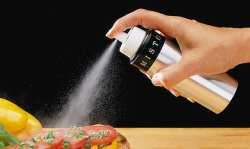
7. BEST. Tip. Ever! If you’re not fast with a brush, or have always had a problem with fillo tearing on you, this tip is custom-made for you. Use olive oil in a spray can. You can find it at most markets or you can buy a refillable bottle (like Misto) and fill it up with your favorite olive oil. Lightly spray the oil directly on the fillo wherever the instructions call for brushing. It’s super fast so fillo doesn’t have time to dry out. Brushing is best since you have more control over how much butter/oil is applied, but, if you need an easier option, this is the next best thing!
Ready, Set, GO!
Now it’s your turn! Get baking and let us know which fillo you used, where you bought it, how it turned out, and what your experience was like. If you have any questions before you get started, we’re here for you!
Sign up for our e-newsletter (if you haven’t already) and stay connected on social media for cooking tips and recipes, as well as for all Kukla's Kouzina updates and news.
Thanks for following us and we’ll see you next Monday!
Until then~
Kali orexi! Good appetite!
Kelly
Kontos (for info)
Athens Fillo Dough/Apollo Fillo (for stores)
The Fillo Factory
Amazon.com
IN ASTORIA, NY
Titan Foods
25-56 31st Street
Astoria, NY, 11102
718-626-7771
Mediterranean Foods (2 locations)
30-12 34th Street
Astoria, NY 11103
718-728-6166
22-78 35th Street
Astoria, NY 11105
718-721-0266
RESOURCES
Athens/Apollo Foods
The Fillo Factory
Kontos Foods
Web design by Kelly Salonica Staikopoulos


